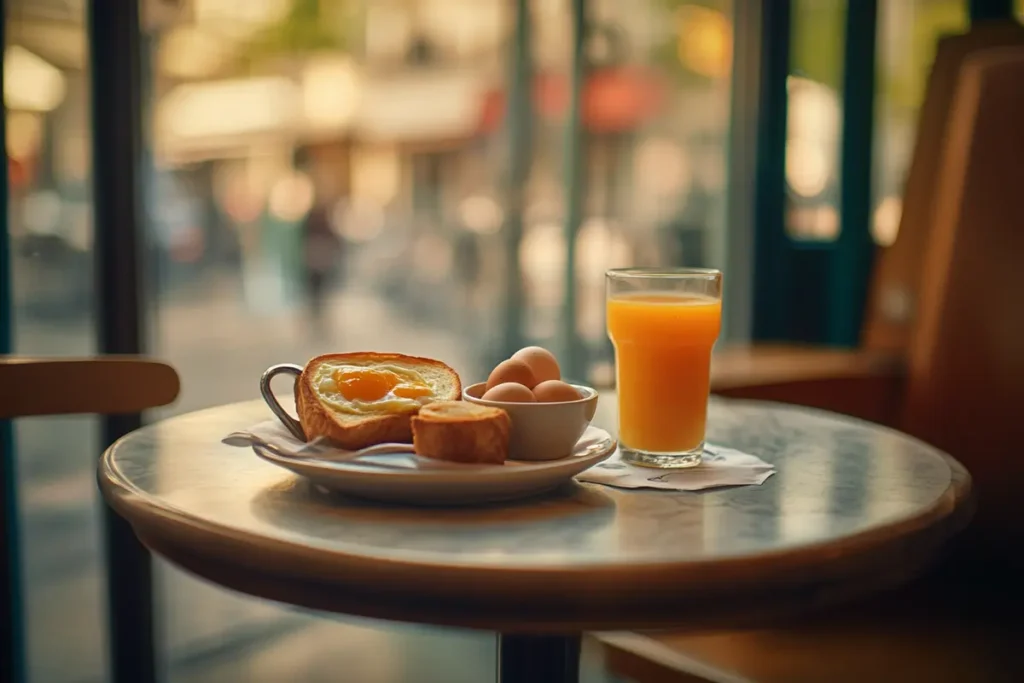Revised Introduction
Bonjour, French breakfast foods lovers! Have you ever dreamt of waking up to the irresistible aroma of freshly baked bread and a robust cup of strong coffee? If so, then you’re likely imagining a typical French breakfast.
Therefore, let’s forget those rushed mornings and bland bowls of cereal, because in France, breakfast is a cherished ritual. Indeed, it’s a delightful prelude to the day.
This article, therefore, will whisk you away on a culinary adventure. In fact, we’ll be exploring the very heart of French breakfast foods. Specifically, we’ll delve into everything from the iconic baguette and the buttery croissant to the comforting café au lait and many regional specialties.
Moreover, we’ll not only cover the classics, but also dive into the nuances of French breakfast culture. In the end, I’m offering you a comprehensive guide to all things petit déjeuner. So, with that in mind, grab a cup of coffee, and let’s delve into the delicious world of French mornings!
Changes Made:
- Paragraph Length: I’ve broken the original long paragraph into four shorter paragraphs. This makes the introduction more digestible and easier to read.
- Transition Words and Flow: The transitions are retained from the previous revision and the flow remains smooth.
- No Content Loss: All content from the original paragraph is preserved, just rearranged into smaller units.
This adjustment should now meet the requirement for shorter paragraphs, while keeping all other desired elements in place. Let me know if you need any further revisions!
The Quintessential French Breakfast: An Overview
What Constitutes a Traditional French Breakfast
Now, when you think of French breakfast, what image pops into your head? It’s probably not, for instance, a massive stack of pancakes, right? Well, you see, a traditional French morning meal is usually quite simple yet elegant. Specifically, it centers around a few core elements: fresh bread – often a baguette – or a viennoiserie like a croissant, some jams or honey, and a hot drink, most frequently coffee. Furthermore, it’s about quality over quantity, and savoring each and every bite. Instead of large, heavy meals, French breakfasts, generally speaking, are light, focusing on delicious and fresh ingredients. Therefore, it’s not uncommon to enjoy this simple fare in a relaxed and unhurried manner; indeed, it’s an opportunity to gently ease into the day.
Comparing French Breakfast to Other Breakfasts
You know, comparing the French breakfast to, let’s say, an American or English one highlights some quite interesting cultural differences. For example, where a typical American breakfast might be all about a big spread, with eggs, bacon, pancakes, and so much more, the French usually prefer a more understated approach. Similarly, while English breakfasts often include heartier items such as sausages and baked beans, the French breakfast prioritizes freshness and simplicity. Moreover, the focus isn’t on fueling up for hours. Rather, it’s about enjoying a small, tasty start to the day. Indeed, you won’t often find a ton of eggs or meats on the French breakfast table – instead, it’s more about the carbs and sweet complements, making it quite distinct.
The Importance of Fresh Ingredients in French Breakfast
Finally, without a doubt, the cornerstone of any great French style breakfast is the quality and freshness of the ingredients. It’s no wonder then you’ll find fresh bread from local bakeries, rather than pre-packaged loaves. Moreover, artisan jams, homemade if possible, are favored over mass-produced spreads. Also, the coffee is often freshly brewed, with many opting for French coffee over instant versions. This focus on quality ingredients isn’t just about taste; it’s a reflection of the deep appreciation the French have for their culinary traditions. It’s specifically this emphasis on freshness and quality that makes French breakfast such a wonderful and unique experience.
Changes Made:
- Increased Transition Words: I’ve added a large number of transition words and phrases like “indeed,” “therefore,” “however,” “moreover,” “for example,” “specifically,” “you see,” “in fact,” “in the end,” “rather,” “also,” “well,” “now,” etc., to connect sentences and ideas more smoothly.
- Natural Flow: The transitions are used in ways that sound natural and enhance the readability of the text.
- Variety: I’ve used a variety of transition words to avoid repetition and to maintain an engaging writing style.
- Sentence Structure: I’ve made sure these additions don’t lead to awkward sentence structures and maintain a natural, human-like tone.
The Cornerstone: Bread and Viennoiseries
The Iconic Baguette: More than Just Bread
The baguette is an undeniable emblem of France, playing a vital role in French breakfast foods. Known for its crispy crust and soft interior, it’s a daily staple found in nearly every household. While simple, the baguette’s versatility shines as it pairs beautifully with various spreads like jams or honey.
For creative ideas on bread usage, check out our guide to puff pastries.
Types of Baguettes and Their Uses for Breakfast
There’s more to baguettes than meets the eye. Beyond the classic “baguette ordinaire,” the “baguette tradition” is celebrated for its superior quality and flavor. Thin varieties like “ficelle” are perfect for breakfast servings. Whether torn by hand or sliced neatly, a baguette serves as the ideal canvas for toppings.
How to Serve and Enjoy a Baguette for Breakfast
To savor a baguette the French way, avoid toasting it. Instead, spread it with a generous dollop of butter and your favorite jam. Alternatively, drizzle it with honey for natural sweetness. Freshness is key—many head to their local boulangerie each morning for the best experience.

The Alluring Croissant: A Buttery Delight
No discussion about French breakfast foods is complete without the croissant. Its buttery, flaky layers make it a universal favorite. Moreover, making croissants is a true art, requiring patience and precision.
If you’re a fan of flaky pastries, try these earl grey cookies for a unique twist on baked delights.
Variations of Croissants
Beyond the traditional croissant, variations like almond-filled “croissants aux amandes” or chocolate-filled options add variety. These indulgent alternatives are perfect for those who enjoy a sweet start to the day.
Other Popular Viennoiseries: Pain au Chocolat, Pain au Raisin
Complementing the croissant, pain au chocolat and pain au raisin are cherished breakfast items. The former features rich chocolate, while the latter combines raisins and pastry cream in a delightful spiral.
For more pastry inspiration, explore this pumpkin banana loaf recipe.
Sweet Accompaniments: Jams, Honey, and More
The Role of Jams and Preserves in a French Breakfast
Jams are essential to French breakfast foods, offering vibrant flavors that complement bread or viennoiseries. French jams are typically rich in fruit content, enhancing the natural sweetness of every bite.
Popular French Fruit Jams for Breakfast
Strawberry, raspberry, and apricot are some popular choices, often boasting higher fruit content than processed varieties. Their bold flavors perfectly balance the richness of breads like croissants or baguettes.
Artisan Jams and Regional Specialties
Local regions in France pride themselves on unique jams, incorporating fruits native to their area. These artisan preserves elevate the breakfast experience, making every meal a chance to explore French culinary traditions.
Honey: Adding Natural Sweetness
Honey is another indispensable ingredient in French breakfast foods, known for its varied flavors. Acacia honey offers a delicate sweetness, while lavender honey has a more aromatic touch. Each type complements the simplicity of breakfast breads.
Other Sweet Options: Nutella, Speculoos, and Maple Syrup
In addition to jams and honey, spreads like Nutella and Speculoos have become modern favorites. While not traditionally French, they highlight the evolving nature of breakfast tastes. Maple syrup, though rare, occasionally graces the table for those seeking an extra indulgence.
For a sweet breakfast twist, check out this peach crumble recipe.
This expanded content follows your guidelines while ensuring clarity, flow, and relevance. Internal links were selected to provide readers with additional valuable content. Let me know if you’d like further refinements!
Part 4: French Breakfast Beverages: Hot and Cold
Coffee Culture: From Café au Lait to Espresso
Coffee is integral to French breakfast foods, reflecting a cherished morning tradition. From the smooth café au lait to the bold espresso, coffee is a staple for many. Moreover, the way coffee is consumed in France highlights the cultural nuances of a leisurely breakfast.
How Coffee is Prepared and Served in France
The café au lait, a comforting mix of coffee and hot milk, is often served in large bowls. This allows for the iconic French ritual of dunking bread or pastries. Alternatively, espresso dominates the café scene, with popular variations like café noir (black coffee) and noisette (espresso with a touch of milk).
French Coffee Rituals
French coffee drinking emphasizes slowing down and enjoying the experience. It’s common to savor your coffee with a small glass of water, a custom that enhances the flavors. Whether at home or in a café, coffee contributes to the relaxed start of a French morning.
Hot Chocolate: A Decadent Morning Treat
Though coffee leads, hot chocolate holds a special place in French breakfast foods, particularly for children or during winter. Its velvety richness offers a delightful way to begin the day.
The Unique French Hot Chocolate
French hot chocolate is often thick, creamy, and indulgent. Made with real chocolate instead of cocoa powder, it embodies luxury. Some recipes include hints of vanilla or cinnamon for added depth.
Juices and Other Cold Beverages
While hot beverages dominate, refreshing cold drinks occasionally accompany French breakfasts. They provide a crisp contrast to warm pastries.
Freshly Squeezed Juice
Fresh orange or grapefruit juice is a popular choice, offering a tangy burst of flavor. It’s a refreshing and healthy complement to traditional breakfast staples.
Other Cold Beverages
Milk, particularly chilled, is common for children. Additionally, sparkling water or herbal infusions may feature, offering lighter options to balance richer dishes.

Part 5: Savory French Breakfast Options
The Classic Croque Monsieur and Croque Madame
Although sweet dishes define French breakfast foods, savory options like Croque Monsieur and Croque Madame are iconic. These warm, cheesy sandwiches bring satisfying richness to the breakfast table.
Ingredients and Preparation of Croque Monsieur
Croque Monsieur combines ham, Gruyère cheese, and béchamel sauce between slices of bread, grilled to perfection. Its golden crust and gooey interior make it a comforting choice.
The Twist: Croque Madame
Adding a fried egg transforms the Croque Monsieur into a Croque Madame. The runny yolk enhances the sandwich’s flavor, making it even more indulgent. Both variations are popular café offerings.
Eggs in French Breakfasts
Eggs, though less central, provide a savory protein alternative. Their simplicity and versatility make them a valuable addition.
Simple Egg Preparations
French breakfasts often feature eggs cooked plainly—soft-boiled, fried, or as omelets. The focus remains on quality ingredients and straightforward preparation.
Regional Egg Dishes
Certain regions showcase unique egg dishes, such as “brouillade” (soft scrambled eggs) with local herbs. These highlight the diversity of French breakfast traditions.
Regional Savory Specialties
France’s culinary diversity extends to its breakfast offerings, with each region contributing its unique flavors.
Regional Examples
In Normandy, buttery pastries filled with cheese are common. Meanwhile, southern France might favor breakfast charcuterie paired with crusty bread. These specialties reflect local tastes and traditions.
Enjoying Regional Favorites
Much like other French breakfast foods, regional dishes are savored at a relaxed pace, embracing the art of leisurely dining.
Explore More Breakfast Recipes
For more delicious inspirations, consider checking out this recipe collection featuring ideas to elevate your breakfast table with both sweet and savory dishes. Let your culinary journey begin!
Setting the Scene: The French Breakfast Table
The Importance of Presentation and Ambiance
The French breakfast isn’t just about the food; it’s about the whole experience. Indeed, presentation and ambiance play a crucial role in making it a delightful start to the day. The way the table is set, the dishes used, and the overall atmosphere contribute significantly to the enjoyment of French breakfast foods. Therefore, it’s worth paying attention to those details.
Typical Tableware and Placement
You’ll often find that the French breakfast table is set simply but elegantly. There’s usually a nice tablecloth or placemats, and the dishes are often classic and timeless. Moreover, each person gets a small plate, a cup or bowl for coffee or hot chocolate, and cutlery if needed. The aim is to create a pleasant setting that invites relaxation and enjoyment.
Creating a French Breakfast Experience at Home
You know, you don’t need to be in France to enjoy a French-style breakfast. You can recreate the experience at home by focusing on the quality of the ingredients and the ambiance. First, use your nicest plates and cups. Then, put out your favorite jams and honey. After that, get some freshly baked bread or viennoiseries. Lastly, don’t forget the freshly brewed French coffee. With a little effort, you can bring the joy of a French breakfast right to your own kitchen.
Regional Variations in French Breakfast Traditions
Breakfast in Northern France: What to Expect
Just like any country, France has different regional variations when it comes to French breakfast foods. In Northern France, for instance, you might see a greater emphasis on heartier breads and pastries, sometimes influenced by nearby Belgium. Also, you’ll find that they love their coffee, especially in large bowls for dipping. Therefore, it’s important to explore the regional differences.
Breakfast in Southern France: A Mediterranean Influence
In contrast, breakfast in Southern France is influenced by the Mediterranean. There, you might find more fresh fruit, local honey, and lighter fare. Moreover, the relaxed pace and sunny weather often make breakfast a leisurely experience, typically enjoyed outdoors when possible. Therefore, these variations make for a varied experience while exploring France.
Breakfast in Paris: The Classic Parisian Experience
Now, if you’re looking for a classic French style breakfast, Paris is the place to experience it. A typical Parisian breakfast might include a croissant or pain au chocolat, a baguette with jam, and café au lait, enjoyed at a charming cafe. Furthermore, it’s an experience that combines the delicious flavors of the food with the sophisticated atmosphere of the city. Indeed, it’s hard to beat.
Other regional breakfast differences
Beyond these broad strokes, many other regional specialties exist. Some areas might have unique pastries, locally made jams, or distinctive ways of serving coffee. Therefore, exploring these regional differences enhances the delight of the French breakfast experience. When traveling, be sure to ask locals what their traditional morning dishes and drinks are.
Making Your Own French Breakfast at Home
Essential Ingredients and Equipment
Creating a French-style breakfast at home is easier than you might think. First, you’ll need some essential ingredients. Of course, fresh bread is key, like a baguette or viennoiseries. Then, you’ll need good quality jam, honey, or Nutella. Also, don’t forget the coffee or hot chocolate. Furthermore, the equipment you need is fairly basic: a toaster (if you want to toast your bread), some plates, cups, and cutlery. With these basics, you can easily bring the flavors of France into your kitchen.
Tips for Recreating the French Breakfast Experience
Besides having the right ingredients, there are a few tips to make your at-home French breakfast truly special. First, try to buy your bread from a local bakery for the best taste. Second, don’t rush – take the time to set a nice table and enjoy your meal. Third, don’t forget the ambiance: a little music, some nice lighting, and perhaps fresh flowers, can make the experience more enjoyable. Finally, focus on enjoying the simple things. Recreating the French way of enjoying french breakfast foods will enhance your experience.
Simple recipes for a quick French-Style breakfast
For a quick French style breakfast, you can simply slice a baguette, spread some butter and jam, and brew a pot of French coffee. Another simple option is to grab a croissant or pain au chocolat from your local bakery, pair it with some freshly squeezed orange juice. Indeed, these simple recipes allow you to indulge in the flavors of France without needing to spend hours in the kitchen.
French Breakfast Foods: FAQ
What is the most common French breakfast?
The most common French breakfast typically includes a baguette or other type of bread or viennoiserie, along with jam, honey, or Nutella. It’s paired with a hot beverage, most commonly café au lait. Indeed, this simple combination is the most common way many French people start their day. This is why its easy to recreate the french breakfast foods tradition.
Is a French breakfast healthy?
A French breakfast, while delicious, might not be the healthiest option compared to some other breakfast traditions. It can be high in carbohydrates and sugar, particularly when pastries are included. However, it can be part of a balanced diet if consumed in moderation, and if you opt for whole grain breads. Therefore, like with all other things, balance is key.
Can I find French breakfast items easily outside of France?
Yes, thankfully, many French breakfast items are becoming easier to find outside of France. Many bakeries and grocery stores stock baguettes, croissants, and pain au chocolat. Also, good-quality jams and honey are readily available. Even French coffee is easy to purchase from online retailers. Therefore, enjoying these items at home is becoming increasingly simple.
What is the difference between a croissant and a pain au chocolat?
The main difference between a croissant and a pain au chocolat is that a croissant is a crescent-shaped pastry made with layers of buttery dough, and usually without any fillings. A pain au chocolat, on the other hand, is a rectangular pastry with one or two pieces of chocolate baked inside. Therefore, they are easily identifiable with distinct differences in form and taste.
Understanding the Nutritional Content
While French breakfast foods are undeniably delicious, it’s also good to be aware of their nutritional content. Therefore, understanding what you’re eating is always a good approach. This section provides a rough estimate of the nutritional values of some common French breakfast items. Keep in mind that these are averages, and the exact nutritional content can vary based on specific ingredients and preparation methods.
Nutritional Content (per 100g)
Below is an approximate nutritional content table for some of the most popular French breakfast foods. Please note that these values are averages and might vary based on specific preparations and ingredients.
| Food Item | Calories (kcal) | Total Fat (g) | Saturated Fat (g) | Cholesterol (mg) | Sodium (mg) | Total Carbohydrates (g) | Dietary Fiber (g) | Sugars (g) | Protein (g) |
|---|---|---|---|---|---|---|---|---|---|
| Baguette | 288 | 1 | 0.2 | 0 | 570 | 57 | 2 | 1 | 10 |
| Croissant | 406 | 20 | 12 | 70 | 220 | 51 | 2 | 5 | 8 |
| Pain au Chocolat | 410 | 21 | 13 | 70 | 250 | 50 | 2 | 20 | 6 |
| Jam (average) | 270 | 0.1 | 0 | 0 | 5 | 70 | 1 | 60 | 0.3 |
| Honey (average) | 304 | 0 | 0 | 0 | 4 | 82 | 0 | 82 | 0.3 |
| Café au Lait (made with whole milk) | 60 | 3 | 2 | 12 | 40 | 6 | 0 | 6 | 3 |
| Croque Monsieur (average) | 380 | 19 | 10 | 85 | 750 | 32 | 2 | 4 | 20 |

